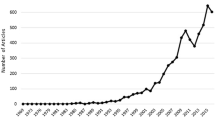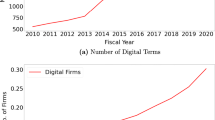Abstract
In a market for ideas, an intermediary often masks buyers’ information that is not to be exposed to the public. This article shows that such obscuration plays an important role in removing excess inertia because it prevents the emergence of a bandwagon effect among buyers. This model applies to outsourcing-type R&D competition. Although innovation is spurred, welfare implications are ambiguous because the competition among buyers becomes harsher than it is in the absence of the intermediary.
Similar content being viewed by others
Notes
SPILL: The wreck of the Exxon Valdez ( http://www.evostc.state.ak.us/facts/details.cfm)
InnoCentive Solver Develops Solution to Help Clean Up Remaining Oil From the 1989 Exxon Valdez Disaster (http://www.innocentive.com/innocentive-solver-develops-solution-help-clean-remaining-oil-1989-exxon-valdez-disaster)
A market for ideas (Economist, September 19th 2009, pp.69–70)
Basic research cannot be generally patented. In addition, many countries limit patents of medical inventions.
Arora and Fosfuri (2003) investigate licenses in detail.
See Farrell and Saloner (1985). Our case is analogous.
Patent grant delay may deter cooperation and licensing (Gans et al. 2008).
Suppose that the firms who know the result of both calls compete after the second call phase. We define competition such that \(\pi _{i}(q_{i}) = (p_{i} - c_{i}) q_{i}\) (Cournot competition) and \(p_{i} = 1 - q_{i} - q_{j}\) (substitute goods). Assume that a firm can reduce its marginal cost from \(c = 1/5\) to zero by incurring an invention cost \(f = 1/20\). In the equilibrium, \(\pi _{i} = 1/9 - f\) if both innovate, \((1-c)^{2}/9\) if neither innovates, \((1+c)^{2}/9 - f\) if i innovates alone and \((1-2c)^{2}/9\) if \(j \neq i\) innovates alone. Then, the inequality \(1/9 - f < (1-c)^{2}/9\) holds, which holds if \(D<1\). Also, \(\{(1+c)^{2}/9-f\}+(1-2c)^{2}/9<(1-c)^{2}/9+(1/9 - f)\) is the counterpart of \(M+0<1+D\).
References
Anton JJ, Yao DA (2002) The sale of ideas: strategic disclosure, property rights, and contracting. Rev Econ Stud 69(3):513–531
Arora A, Fosfuri A (2003) Licensing the market for technology. J Econ Behav Organ 52(2):277–295
Arrow KJ (1962) Economic welfare and the allocation of resources for invention. In: Nelson RR (ed) The rate and direction of inventive activity. Princeton University Press, Princeton, pp 609–625
Chesbrough H (2006) Open business models: how to thrive in the new innovation landscape. Harvard Business School Press, New York
Farrell J, Saloner G (1985) Standardization, compatibility, and innovation. RAND J Econ 16(1):70–83
Gans JS, Stern S (2010) Is there a market for ideas? Ind Corp Chang 19(3):805–837
Gans JS, Hsu DH, Stern S (2008) The impact of uncertain intellectual property rights on the market for ideas: evidence for patent grant delays. Manag Sci 54(5):982–997
Garella PG, Peitz M (2000) Intermediation can replace certification. J Econ Manag Strateg 9(1):1–24
Hagiu A, Jullien B (2011) Why do intermediaries divert search? RAND J Econ 42(2):337–362
Hellman T, Perotti E (2011) The circulation of ideas in firms and markets. Manag Sci 57(10):1813–1826
Kennes J, Schiff A (2008) Quality infomediation in search markets. Int J Ind Organ 26(5):1191–1202
Lizzeri A (1999) Information revelation and certification intermediaries. RAND J Econ 30(2):214–231
Masters A (2007) Middlemen in search equilibrium. Int Econ Rev 48(1):343–362
Piatt JF, Ford RG (1996) How many seabirds were killed by the Exxon Valdez oil spill? In: American fisheries society symposium 18, pp 712–719
Topkis DM (1978) Minimizing a submodular function on a lattice. Oper Res 26(2):305–321
Author information
Authors and Affiliations
Corresponding author
Appendix: Proofs
Appendix: Proofs
Lemma 1
Let us define \(\phi (a_{1},a_{2}):=U(a_{1},a_{1})+U(a_{2},a_{2})-U(a_{1},a_{2})-U(a_{2},a_{1})\), where \(a_{i} \in \{n,w,d\}\) and U is the payoff function of a firm. Then, \(\phi (n,w) = \lambda (1 + D - M)\), \(\phi (w,d) = (1 - \lambda ) (1-D+\theta _{i}+\rho )\) and \(\phi (n,d) = 1+D-M\) are non-negative, which prove supermodularity. In addition, the payoff function has decreasing differences in \((a_{i},\theta _{i})\). Hence, on the basis of Topkis (1978), a lower-type firm employs a higher-order strategy.
Proposition 1
When \(\theta _{i} = 1\), n dominates w and d for firm i because \(M-1 < D < 1\). Comparing n and w, we can see that \(\theta _{i} < D\) chooses w or d. Suppose, first, that some type chooses w or d. For a firm such that n and w are indifferent, \(\bar \theta = D\). In addition, \((1-\bar \theta )(M-\underline \theta )+ (\bar \theta -\underline \theta )(D-\underline \theta ) = (1-\underline \theta ) \cdot 1\) if w and d are indifferent. However, the solutions are \(\underline \theta < 0\) or \(\underline \theta > D = \bar \theta \), which is a contradiction. Next, suppose that w is not chosen. Then, the threshold between n and d occurs at \(\theta _{i} = \frac {M-1}{M-D} \in (0,D)\), but in the range between this threshold and D, a firm becomes better off by changing its strategy from n to w. Thus, d is excluded.
Lemma 2
Recall that an interior solution is assumed in Eqs. 1 and 2. These equations being transformed, we see that the thresholds must satisfy
By subtracting Eq. 4 from Eq. 3, we obtain
The value function can be rewritten as
using Eqs. 4 and 5. For the agent to maximize its profit, \(\bar \theta \) and \(\underline \theta \) should be large. In addition to this, for any \(\rho \), \(\bar \theta \) and \(\underline \theta \) increase as \(\lambda \) increases in Eq. 5. Thus, \(\lambda = 1\) in equilibrium. For this proof, an intersection of Eqs. 4 (a quadratic curve that is downwardly convex) and 5 (a line) is checked in the \(\underline \theta -\bar \theta \) plane. The line always passes through the point \((D-\rho ,D-\rho )\) located under the rising quadratic curve. A larger. \(\lambda \) makes the slope of the line steeper (Fig. 1). The other intersection, \(\theta _{i} < 0\), should not be a solution.
Now, w and d are indifferent for the firms, so we will consider that n and d meet at \(\bar \theta = \underline \theta \) determined as follows: \((1-\bar \theta ) M + \bar \theta D - \bar \theta - \rho = (1-\bar \theta ) \cdot 1 + \bar \theta \cdot 0\). By substitution of \(\bar \theta \), the optimization problem \(\max _{\rho } V|_{\lambda = 1} = \rho \bar \theta \) is transformed into \(\max _{\rho } \rho (M-1-\rho )\). The solution is \(\rho = \frac {M-1}{2}\).
Proposition 2
By Lemma 2, \(\lambda = 1\) and \(\rho = \frac {M-1}{2}\). At \(\underline \theta \),
so the threshold \(\underline \theta = \frac {M-1}{2(M-D)}\).
Rights and permissions
About this article
Cite this article
Nishihara, Y. An Anonymous Buyer of Intangible Property. J Ind Compet Trade 14, 511–518 (2014). https://doi.org/10.1007/s10842-013-0173-x
Received:
Revised:
Accepted:
Published:
Issue Date:
DOI: https://doi.org/10.1007/s10842-013-0173-x





